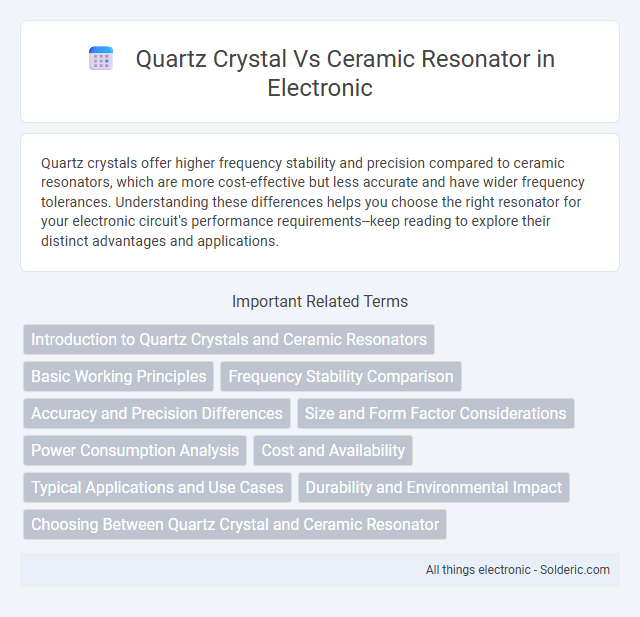Quartz crystals offer higher frequency stability and precision compared to ceramic resonators, which are more cost-effective but less accurate and have wider frequency tolerances. Understanding these differences helps you choose the right resonator for your electronic circuit's performance requirements--keep reading to explore their distinct advantages and applications.
Comparison Table
| Feature | Quartz Crystal | Ceramic Resonator |
|---|---|---|
| Frequency Accuracy | +-10 to +-30 ppm | +-0.5% to +-1.0% |
| Frequency Stability | Excellent, low drift | Moderate, higher drift |
| Operating Frequency Range | 1 kHz to 200 MHz | 100 kHz to 30 MHz |
| Cost | Higher | Lower |
| Size | Generally larger | Smaller, compact |
| Temperature Sensitivity | Low, stable over temperature | Higher sensitivity |
| Application | Precision timing, clocks, communication | Consumer electronics, low-cost timing |
| Quality Factor (Q) | High (10,000 to 100,000) | Low (1,000 to 3,000) |
Introduction to Quartz Crystals and Ceramic Resonators
Quartz crystals provide highly accurate frequency control due to their piezoelectric properties, commonly used in precision timing applications like watches and communication devices. Ceramic resonators offer a cost-effective alternative with moderate stability and frequency tolerance, suitable for less sensitive electronic circuits such as microcontrollers and consumer electronics. Your choice between quartz crystals and ceramic resonators depends on the required frequency accuracy and budget constraints of your project.
Basic Working Principles
Quartz crystals operate based on the piezoelectric effect, where an applied electric field causes mechanical vibrations at a precise resonant frequency, ensuring stable oscillations. Ceramic resonators use the mechanical resonance of piezoelectric ceramic material, producing oscillations with a lower frequency stability compared to quartz crystals. The inherently higher Q factor of quartz results in more accurate frequency control, making it ideal for precision timing applications.
Frequency Stability Comparison
Quartz crystals exhibit superior frequency stability compared to ceramic resonators due to their precise piezoelectric properties and minimal temperature drift. Ceramic resonators tend to have higher frequency variation over temperature and aging, making them less reliable for applications requiring strict timing accuracy. When your application demands consistent frequency stability, quartz crystals are the preferred choice.
Accuracy and Precision Differences
Quartz crystals offer superior accuracy and precision with frequency stability typically within +-10 ppm, making them ideal for applications requiring exact timing. Ceramic resonators exhibit lower accuracy, usually around +-0.5% to +-0.1%, resulting in higher frequency drift and less precise signal generation. The inherent piezoelectric properties of quartz provide consistent oscillation frequency, while ceramic resonators rely on mechanical resonance with greater variability.
Size and Form Factor Considerations
Quartz crystals typically offer smaller size and more compact form factors compared to ceramic resonators, making them preferable for space-constrained applications. Their precise frequency stability allows for minimal package dimensions without sacrificing performance, often available in surface-mount device (SMD) formats. Ceramic resonators, while generally larger and bulkier, provide cost-effective alternatives with less stringent size requirements but may demand more PCB space due to their relatively larger package sizes.
Power Consumption Analysis
Quartz crystals exhibit lower power consumption compared to ceramic resonators due to their higher Q-factor, which enhances frequency stability and reduces energy loss. Ceramic resonators typically require higher drive levels, leading to increased power usage in oscillation circuits. Optimizing oscillator design with quartz crystals can significantly improve energy efficiency in battery-powered and low-power electronic applications.
Cost and Availability
Quartz crystals typically offer higher accuracy and stability than ceramic resonators but come at a higher cost and lower availability in bulk quantities. Ceramic resonators are more cost-effective and widely available, making them a preferred choice for budget-sensitive or high-volume applications. Your project's budget and required precision will determine whether the premium of a quartz crystal or the affordability of a ceramic resonator aligns better with your needs.
Typical Applications and Use Cases
Quartz crystals are widely used in high-precision applications such as wristwatches, radios, and microprocessors due to their superior frequency stability and low phase noise. Ceramic resonators find common use in cost-sensitive and less frequency-critical devices like remote controls, toys, and consumer electronics where moderate accuracy suffices. Both components serve clock generation and timing functions but differ significantly in accuracy requirements and environmental stability throughout various embedded system applications.
Durability and Environmental Impact
Quartz crystal resonators offer superior durability and stability under extreme temperature and environmental conditions, maintaining consistent frequency performance over time. Ceramic resonators, while less precise, are more resistant to mechanical shock and vibration due to their rugged construction, making them suitable for cost-sensitive and less demanding applications. Your choice between the two should consider the long-term environmental impact, as quartz crystals typically require more energy-intensive manufacturing processes, whereas ceramic resonators are often produced with fewer hazardous materials and lower energy consumption.
Choosing Between Quartz Crystal and Ceramic Resonator
Quartz crystals provide superior frequency stability and accuracy, making them ideal for precision applications such as communication devices and timekeeping. Ceramic resonators are more cost-effective and offer faster start-up times, suitable for general-purpose circuits where moderate frequency tolerance is acceptable. Selecting between them depends on the required frequency precision, environmental stability, and budget constraints of the project.
quartz crystal vs ceramic resonator Infographic

 solderic.com
solderic.com